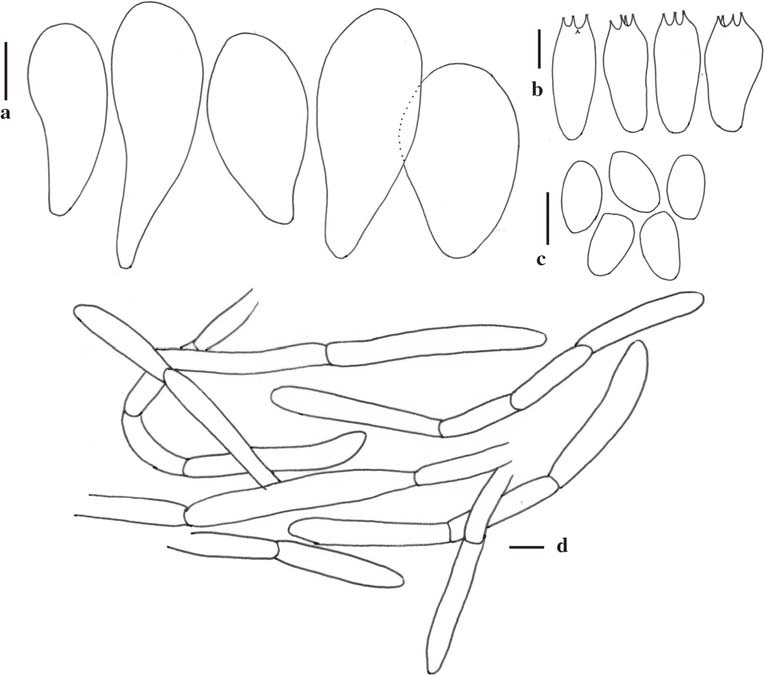Agaricus parvibicolor L.J. Chen, R.L. Zhao & K.D. Hyde
Index Fungorum number: IF550999 Facesoffungi number: FoF00467
Etymology: Refers to the size of sporocarps and the white and violaceous pileus.
Holotype: MFLU 12–0953 Pileus 15–40 mm diam., 1 mm thick, first parabolic, then hemisphaerical to convex, and finally applanate; surface dry, with reddish brown to violet brown fibrils, densely arranged at disc, very few or none towards the margin on a white background; occasionally, with pileus expansion, starting from the centre, the surface disrupted into triangular fibrillose
squamules; margin crenulate, at times appendiculate by remnants from of the annulus, finely striate when sporocarps become mature; Lamellae free, crowded, lamellulae with more than 5 series, 3–4 mm broad, at first white, then pinkish, later greyish-brown and finally dark brown. Stipe 32–57×2.5–5 mm, fistulose, cylindrical to slightly bulbous at base, with numerous rhizomorphs, surface white, staining orange by handing or bruising, smooth above annulus, fibrillose below. Annulus membranous, single, white, fragile. Context, firm, white. Odour strong of almonds. Basidiospores 4.7–5.5 (–5.7)×3–3.5 (–3.7) μm, (x=5.2×3.3μm, Q=1.39–1.77, Qm=1.55, n=20), ellipsoid to oblong, smooth, brown, thick–walled. Basidia 10–17×5.5–8μm, clavate to broadly clavate, hyaline, smooth, 4-spored. Cheilocystidia 18–38×7.5–13μm, abundant, simple, broadly clavate, pyriform or sphaeropedunculate, hyaline, smooth. Pleurocystidia absent. Pileipellis a cutis composed of hyphae of 5–9μm diam., cylindrical, light brown, smooth, at times slightly constricted at the septa.
Macrochemical reactions: KOH reaction positive yellow. Schäffer’s reaction positive reddish orange.
Habit: gregarious in small groups or solitary in soil of grassland.
Material examined: THAILAND, Chiang Rai Province, Mae Fah Luang University, 21 July 2012, collector Jie Chen, LD2012116 (MFLU 12–0953, holotype). GenBank ITS: KP715162; Chiang Rai Province, Mae fah Luang University, 13 July 2012, collector Jie Chen, LD201288 (MFLU 12–0926), GenBank ITS: KP715165; LD201295 (MFLU 12–0933), GenBank ITS: KP715164; Mae Fah
Luang University, 21 July 2012, collector Jie Chen, LD2012118 (MFLU 12–0954), GenBank ITS: KP715163; Mae Souy Dist., Pamae Lao National Park., 2 August 2006, collected by Ruilin Zhao, ZRL3091 (SFSU).
Notes: The positive KOH and Schäffer’s reactions and almond- like odour suggest this species belongs to Agaricus section Minores. Agaricus parvibicolor is characterized by its slender sporocarps, with reddish-brown to violet brown fibrils at the centre of the pileus surface, and whitish towards the margin, the simple cheilocystidia, frequently broadly clavate or sphaeropedunculate in shape, the spore with an average size of 5.2×3.3μm.Morphologically, the most similar species is A. purpurellus (F.H. Møller) F.H. Møller, which also shares a slender sporocarp and purplish fibrillose pileus. However, A. purpurellus shows an entirely purplish pileus, slightly wider in spore size (5.16×4μm) and a distinctive habitat of conifer woods (Parra 2013). Another species with reddish-purple fibrils on the disc, but white elsewhere, is A. dulcidulus Schulzer, but it can be easily distinguished by its much smaller spore size which average is to 4.31×3μm (Parra 2013). In the phylogenetic analysis, A. parvibicolor forms a single clade in Agaricus section Minores.

a–d Agaricus parvibicolor (MFLU 12 0953, holotype) a Sporocarps in situ. b Pileus characters. Finely striate on the margin. d Membranous annulus. e–h Agaricus sodalis (MFLU 12–0987, holotype) e Sporocarps in situ. f Sporocarp. g Lamellae and annulus. h Staining yellow when cut. Scale bars: a–
h=10 mm

Agaricus parvibicolor (holotype) a Cheilocystidia b Basidia c Basidiospores d Pileipellis. Scale bars: a c=5μm, d=10μm
Read more: http://link.springer.com/article/10.1007/s13225-015-0324-y

